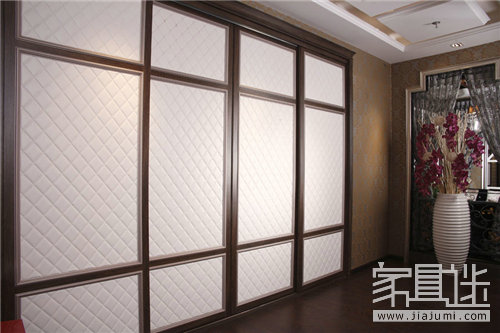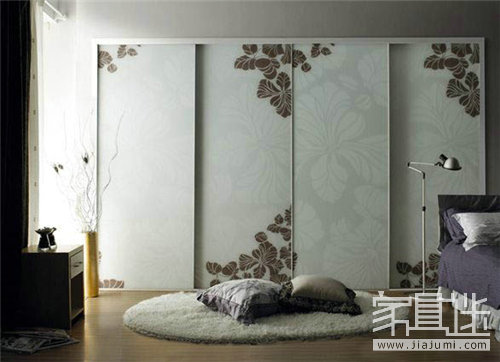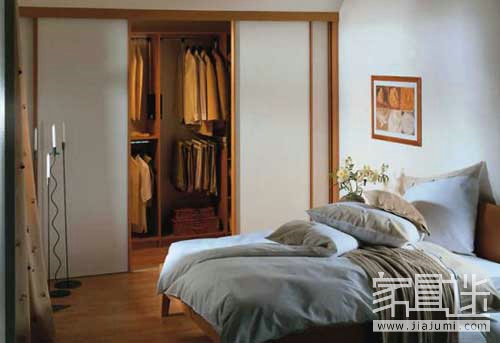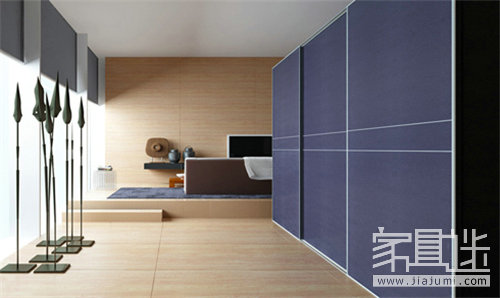With the evolution of home design and furniture concepts, more people are now focusing on space-saving, compactness, flexibility, and convenience. Sliding doors have become a popular choice among modern families due to their sleek and stylish appearance. They not only help in dividing spaces but also allow for a seamless flow between areas—whether the space is open or closed, functional or aesthetic, sliding doors add versatility and richness to the living environment. However, because they are used frequently, sliding doors can develop issues over time. Therefore, it's crucial to understand the product before purchasing to ensure you get high-quality sliding doors that last.
 One of the first things to check when selecting a sliding door is whether the top roller and the track are tightly engaged. The top roller acts as a guide, so when you shake the door vertically along the track, the less movement there is, the better the stability. Pay close attention to the gap between the roller and the track—if the door is of good quality, this gap should be minimal, ensuring smooth and quiet operation. A tight fit between the roller and track is essential for a seamless sliding experience.
One of the first things to check when selecting a sliding door is whether the top roller and the track are tightly engaged. The top roller acts as a guide, so when you shake the door vertically along the track, the less movement there is, the better the stability. Pay close attention to the gap between the roller and the track—if the door is of good quality, this gap should be minimal, ensuring smooth and quiet operation. A tight fit between the roller and track is essential for a seamless sliding experience.
 Another important component is the stop device. When the door closes, it may hit the wall with a slight rebound, causing it to move sideways instead of stopping smoothly. A well-designed stop block helps prevent this by providing resistance. These blocks are typically made from steel or copper. While steel is durable, it can deform over time due to repeated impact. Copper, on the other hand, is more resistant to wear and maintains its shape longer, making it a better long-term choice.
Another important component is the stop device. When the door closes, it may hit the wall with a slight rebound, causing it to move sideways instead of stopping smoothly. A well-designed stop block helps prevent this by providing resistance. These blocks are typically made from steel or copper. While steel is durable, it can deform over time due to repeated impact. Copper, on the other hand, is more resistant to wear and maintains its shape longer, making it a better long-term choice.
 The frame material is another key factor to consider. Common options include carbon steel, aluminum-magnesium alloy, and aluminum-titanium alloy. Carbon steel offers a wide range of color options but is prone to rust. Aluminum-magnesium alloy has a decorative magnesium layer, while aluminum-titanium alloy is a high-strength material often used in aerospace applications. It’s known for its light weight and durability, though it comes at a higher price. When choosing, you can tap the frame lightly—aluminum-titanium alloy will produce a crisp metallic sound. Be cautious of manufacturers claiming to use real titanium alloy, and always ask for an inspection report if possible.
The frame material is another key factor to consider. Common options include carbon steel, aluminum-magnesium alloy, and aluminum-titanium alloy. Carbon steel offers a wide range of color options but is prone to rust. Aluminum-magnesium alloy has a decorative magnesium layer, while aluminum-titanium alloy is a high-strength material often used in aerospace applications. It’s known for its light weight and durability, though it comes at a higher price. When choosing, you can tap the frame lightly—aluminum-titanium alloy will produce a crisp metallic sound. Be cautious of manufacturers claiming to use real titanium alloy, and always ask for an inspection report if possible.
 Don’t overlook small accessories like anti-jump devices, damping systems, and height adjustment mechanisms. Anti-jump devices prevent the door from coming off the track, while damping systems reduce vibration for smoother movement. Height adjustment systems help align the door with the floor and prevent dust entry. A good dust brush at the door-to-door joint is also essential to keep dust out and protect the door from damage. If your sliding door uses glass panels, make sure there’s a rubber seal where the glass meets the frame to prevent cracking from vibrations.
Don’t overlook small accessories like anti-jump devices, damping systems, and height adjustment mechanisms. Anti-jump devices prevent the door from coming off the track, while damping systems reduce vibration for smoother movement. Height adjustment systems help align the door with the floor and prevent dust entry. A good dust brush at the door-to-door joint is also essential to keep dust out and protect the door from damage. If your sliding door uses glass panels, make sure there’s a rubber seal where the glass meets the frame to prevent cracking from vibrations.
 When testing a sliding door, don't assume that lighter means better. A high-quality door should have just the right weight—too light may feel unstable, while too heavy could cause strain. The ideal sliding experience is smooth, controlled, and free of vibrations. Some doors may seem easy to push, but they might lack stability, giving a “floating†sensation.
Listening for noise during operation is also a reliable indicator of quality. A noisy sliding door usually indicates poor bearing pulleys or improper gaps. Some sellers may oil the wheels to make them quieter initially, but this can lead to dirt buildup and eventual noise once the oil dries. Always test the door carefully and listen for any unusual sounds.
For unique spaces, such as sloped ceilings or awkward corners, special sliding doors can be a great solution. Angled doors can match sloped ceilings, while corner doors make efficient use of otherwise wasted space, blending seamlessly into the room’s design.
Sliding doors come in two main types: partitions and cabinet doors. Partition doors are ideal for creating open, flowing spaces, often using transparent glass to maintain visibility and openness. Cabinet doors, on the other hand, combine with furniture and offer various panel styles, from natural wood to metal or fabric finishes, allowing for personalized design choices.
Finally, the bottom wheel plays a critical role in the performance of a sliding door. High-quality wheels are made with materials like carbon fiber glass and non-drying lubricants, ensuring smooth and long-lasting operation. Poor-quality wheels made from plastic may look fine at first but can easily deform over time, affecting the door’s functionality.
When testing a sliding door, don't assume that lighter means better. A high-quality door should have just the right weight—too light may feel unstable, while too heavy could cause strain. The ideal sliding experience is smooth, controlled, and free of vibrations. Some doors may seem easy to push, but they might lack stability, giving a “floating†sensation.
Listening for noise during operation is also a reliable indicator of quality. A noisy sliding door usually indicates poor bearing pulleys or improper gaps. Some sellers may oil the wheels to make them quieter initially, but this can lead to dirt buildup and eventual noise once the oil dries. Always test the door carefully and listen for any unusual sounds.
For unique spaces, such as sloped ceilings or awkward corners, special sliding doors can be a great solution. Angled doors can match sloped ceilings, while corner doors make efficient use of otherwise wasted space, blending seamlessly into the room’s design.
Sliding doors come in two main types: partitions and cabinet doors. Partition doors are ideal for creating open, flowing spaces, often using transparent glass to maintain visibility and openness. Cabinet doors, on the other hand, combine with furniture and offer various panel styles, from natural wood to metal or fabric finishes, allowing for personalized design choices.
Finally, the bottom wheel plays a critical role in the performance of a sliding door. High-quality wheels are made with materials like carbon fiber glass and non-drying lubricants, ensuring smooth and long-lasting operation. Poor-quality wheels made from plastic may look fine at first but can easily deform over time, affecting the door’s functionality.
 Lastly, pay attention to the door’s sealing. Many sliding doors have external bottom wheels, which can create gaps and reduce airtightness. Opting for built-in wheels with strong bearings can improve the seal and reduce dust infiltration. A good sealing brush should have strong adhesive and durable bristles to ensure a tight closure.
Related reading: eight key points of sliding door wardrobe purchase
Lastly, pay attention to the door’s sealing. Many sliding doors have external bottom wheels, which can create gaps and reduce airtightness. Opting for built-in wheels with strong bearings can improve the seal and reduce dust infiltration. A good sealing brush should have strong adhesive and durable bristles to ensure a tight closure.
Related reading: eight key points of sliding door wardrobe purchase
 One of the first things to check when selecting a sliding door is whether the top roller and the track are tightly engaged. The top roller acts as a guide, so when you shake the door vertically along the track, the less movement there is, the better the stability. Pay close attention to the gap between the roller and the track—if the door is of good quality, this gap should be minimal, ensuring smooth and quiet operation. A tight fit between the roller and track is essential for a seamless sliding experience.
One of the first things to check when selecting a sliding door is whether the top roller and the track are tightly engaged. The top roller acts as a guide, so when you shake the door vertically along the track, the less movement there is, the better the stability. Pay close attention to the gap between the roller and the track—if the door is of good quality, this gap should be minimal, ensuring smooth and quiet operation. A tight fit between the roller and track is essential for a seamless sliding experience.
 Another important component is the stop device. When the door closes, it may hit the wall with a slight rebound, causing it to move sideways instead of stopping smoothly. A well-designed stop block helps prevent this by providing resistance. These blocks are typically made from steel or copper. While steel is durable, it can deform over time due to repeated impact. Copper, on the other hand, is more resistant to wear and maintains its shape longer, making it a better long-term choice.
Another important component is the stop device. When the door closes, it may hit the wall with a slight rebound, causing it to move sideways instead of stopping smoothly. A well-designed stop block helps prevent this by providing resistance. These blocks are typically made from steel or copper. While steel is durable, it can deform over time due to repeated impact. Copper, on the other hand, is more resistant to wear and maintains its shape longer, making it a better long-term choice.
 The frame material is another key factor to consider. Common options include carbon steel, aluminum-magnesium alloy, and aluminum-titanium alloy. Carbon steel offers a wide range of color options but is prone to rust. Aluminum-magnesium alloy has a decorative magnesium layer, while aluminum-titanium alloy is a high-strength material often used in aerospace applications. It’s known for its light weight and durability, though it comes at a higher price. When choosing, you can tap the frame lightly—aluminum-titanium alloy will produce a crisp metallic sound. Be cautious of manufacturers claiming to use real titanium alloy, and always ask for an inspection report if possible.
The frame material is another key factor to consider. Common options include carbon steel, aluminum-magnesium alloy, and aluminum-titanium alloy. Carbon steel offers a wide range of color options but is prone to rust. Aluminum-magnesium alloy has a decorative magnesium layer, while aluminum-titanium alloy is a high-strength material often used in aerospace applications. It’s known for its light weight and durability, though it comes at a higher price. When choosing, you can tap the frame lightly—aluminum-titanium alloy will produce a crisp metallic sound. Be cautious of manufacturers claiming to use real titanium alloy, and always ask for an inspection report if possible.
 Don’t overlook small accessories like anti-jump devices, damping systems, and height adjustment mechanisms. Anti-jump devices prevent the door from coming off the track, while damping systems reduce vibration for smoother movement. Height adjustment systems help align the door with the floor and prevent dust entry. A good dust brush at the door-to-door joint is also essential to keep dust out and protect the door from damage. If your sliding door uses glass panels, make sure there’s a rubber seal where the glass meets the frame to prevent cracking from vibrations.
Don’t overlook small accessories like anti-jump devices, damping systems, and height adjustment mechanisms. Anti-jump devices prevent the door from coming off the track, while damping systems reduce vibration for smoother movement. Height adjustment systems help align the door with the floor and prevent dust entry. A good dust brush at the door-to-door joint is also essential to keep dust out and protect the door from damage. If your sliding door uses glass panels, make sure there’s a rubber seal where the glass meets the frame to prevent cracking from vibrations.
 When testing a sliding door, don't assume that lighter means better. A high-quality door should have just the right weight—too light may feel unstable, while too heavy could cause strain. The ideal sliding experience is smooth, controlled, and free of vibrations. Some doors may seem easy to push, but they might lack stability, giving a “floating†sensation.
Listening for noise during operation is also a reliable indicator of quality. A noisy sliding door usually indicates poor bearing pulleys or improper gaps. Some sellers may oil the wheels to make them quieter initially, but this can lead to dirt buildup and eventual noise once the oil dries. Always test the door carefully and listen for any unusual sounds.
For unique spaces, such as sloped ceilings or awkward corners, special sliding doors can be a great solution. Angled doors can match sloped ceilings, while corner doors make efficient use of otherwise wasted space, blending seamlessly into the room’s design.
Sliding doors come in two main types: partitions and cabinet doors. Partition doors are ideal for creating open, flowing spaces, often using transparent glass to maintain visibility and openness. Cabinet doors, on the other hand, combine with furniture and offer various panel styles, from natural wood to metal or fabric finishes, allowing for personalized design choices.
Finally, the bottom wheel plays a critical role in the performance of a sliding door. High-quality wheels are made with materials like carbon fiber glass and non-drying lubricants, ensuring smooth and long-lasting operation. Poor-quality wheels made from plastic may look fine at first but can easily deform over time, affecting the door’s functionality.
When testing a sliding door, don't assume that lighter means better. A high-quality door should have just the right weight—too light may feel unstable, while too heavy could cause strain. The ideal sliding experience is smooth, controlled, and free of vibrations. Some doors may seem easy to push, but they might lack stability, giving a “floating†sensation.
Listening for noise during operation is also a reliable indicator of quality. A noisy sliding door usually indicates poor bearing pulleys or improper gaps. Some sellers may oil the wheels to make them quieter initially, but this can lead to dirt buildup and eventual noise once the oil dries. Always test the door carefully and listen for any unusual sounds.
For unique spaces, such as sloped ceilings or awkward corners, special sliding doors can be a great solution. Angled doors can match sloped ceilings, while corner doors make efficient use of otherwise wasted space, blending seamlessly into the room’s design.
Sliding doors come in two main types: partitions and cabinet doors. Partition doors are ideal for creating open, flowing spaces, often using transparent glass to maintain visibility and openness. Cabinet doors, on the other hand, combine with furniture and offer various panel styles, from natural wood to metal or fabric finishes, allowing for personalized design choices.
Finally, the bottom wheel plays a critical role in the performance of a sliding door. High-quality wheels are made with materials like carbon fiber glass and non-drying lubricants, ensuring smooth and long-lasting operation. Poor-quality wheels made from plastic may look fine at first but can easily deform over time, affecting the door’s functionality.
 Lastly, pay attention to the door’s sealing. Many sliding doors have external bottom wheels, which can create gaps and reduce airtightness. Opting for built-in wheels with strong bearings can improve the seal and reduce dust infiltration. A good sealing brush should have strong adhesive and durable bristles to ensure a tight closure.
Related reading: eight key points of sliding door wardrobe purchase
Lastly, pay attention to the door’s sealing. Many sliding doors have external bottom wheels, which can create gaps and reduce airtightness. Opting for built-in wheels with strong bearings can improve the seal and reduce dust infiltration. A good sealing brush should have strong adhesive and durable bristles to ensure a tight closure.
Related reading: eight key points of sliding door wardrobe purchaseBulk grain van has van, tank car, and some cars also with such as air suction and other special loading and unloading functions. In general, bulk grain transport vehicles with loading and unloading speed, to prevent sand and snow effect, suitable for large tonnage transport and other characteristics, widely used in grain-producing farms, large grain depots, flour mills, instant noodles factory, Food transport
Bulk Truck,Bulk Feed Transport Truck,Bulk Powder Truck,Bulk Grain Transport Truck
CLW GROUP TRUCK , https://www.clwgrouptruck.net
